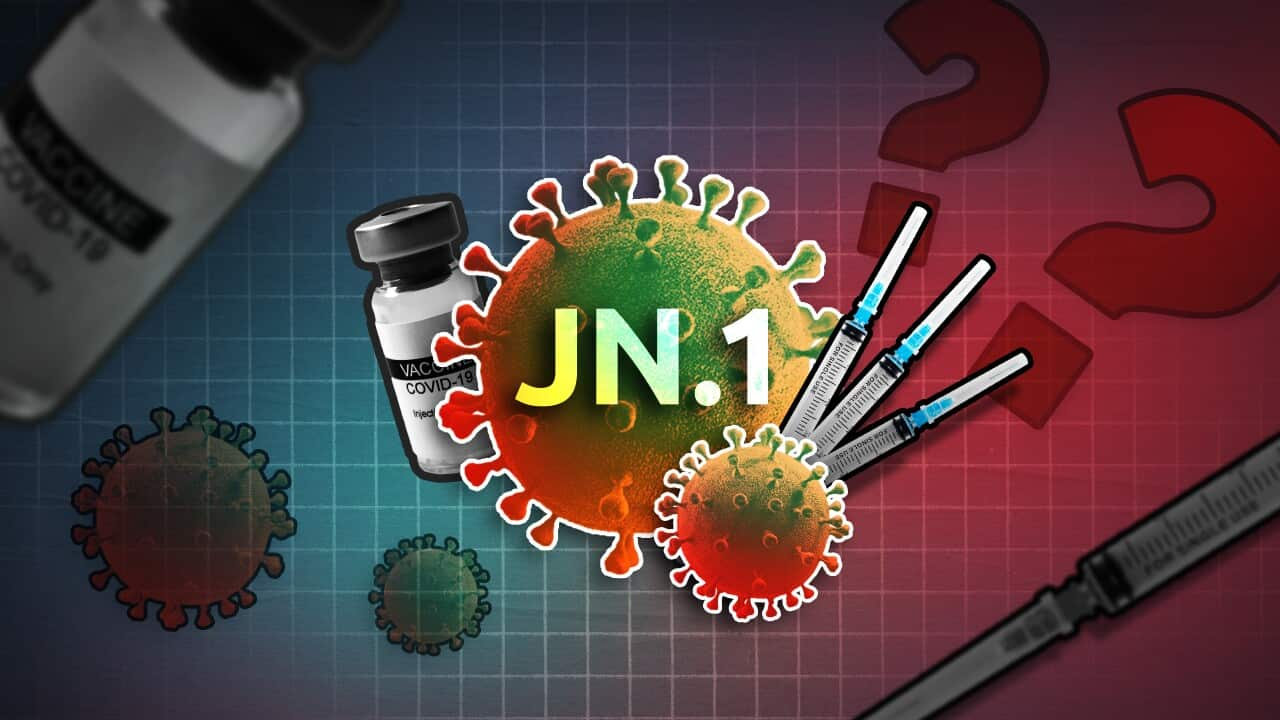Almost four years into the COVID-19 pandemic, the JN.1 variant is driving — and around the world.
Now, experts say it's starting to become a dominant strain, with NSW and Victoria recording a recent spike in cases and hospitalisations.
Other states have recorded more gradual waves as a result of the sub-variant, with Western Australia reporting fewer cases in the lead-up to Christmas and Queensland seeing a prolonged and sustained surge in cases since October 2023.
As the virus that causes COVID-19, SARS-CoV-2, continues to change and mutate, new variants emerge that find ways to better evade our immune system.
So, how protected are we?
What do we know about JN.1?
JN.1 emerged from the Omicron variant BA.2.86, known as Pirola, which made waves when first discovered in July 2023, according to Professor Adrian Esterman, an epidemiologist from the University of South Australia.
"It was so different to the other Omicron sub-variants," he told SBS News.
"It was a major shift."
While Esterman said there were early concerns at the time that BA.2.86 would become a dominant variant around the world, this did not happen.
"Even though it was more transmissible than other variants, it had this problem that it couldn't take off because it had more trouble sticking to its cells," he said.
"Shortly afterwards, it mutated."
Virologist Stuart Turville, from the University of New South Wales' Kirby Institute, said what defines JN.1 as a sub-lineage of BA.2.86 is a "single change" in the spike protein of the virus — the area where the virus sticks to cells.
"That's typically an area where antibodies are found, and they can prevent the virus from infecting cells. By changing that singular amino acid, it makes the virus a little more slippery, and a little better for the virus to navigate around."
Esterman said this spike protein mutation is causing concern.
"It's allowing JN.1 to better evade our immune system," he said.
"So even if you've recently had COVID-19 or been vaccinated, it has made it much easier for JN.1 to infect you. This is why we're seeing it now starting to dominate around the world."
Is JN.1 more transmissible? More severe?
Esterman said sub-variants like JN.1 gain an advantage by becoming more transmissible — but are not necessarily more severe.
"Real-world data shows that [JN.1] doesn't appear to be more severe, but some lab data shows it could be," he said.
Turville also noted that initial reports indicate JN.1 "hasn't significantly picked up a signal of severity compared to other variants that are in circulation".
"Severity is always a really tricky question ... it's important to compare like with like, and the only thing we can compare it with at the moment is the pre-existing XBB Omicron that was circulating at the back end of 2023."
He described JN.1 as "virologically very interesting" but stresses there's a lot we still don't know.
"I don't think we really understand what it's doing yet," he said.
"But we certainly know that it has an advantage of being transmitted very well."
How is JN.1 circulating in Australia - and around the world?
In the United States, JN.1 is estimated to cause more than 60 per cent of COVID-19 cases, according to the Centers for Disease Control and Prevention (CDC).
In early November last year, this proportion was less than 5 per cent.
Esterman stressed it is difficult to understand the full picture in Australia due to an absence of comprehensive COVID-19 data.
"It's very difficult to get hold of the actual numbers," he said.
Last week, NSW health authorities revealed testing showed the proportion of JN.1 cases rising sharply from late November 2023 and increasing into December.
It now makes up more than a third of the state's COVID-19 cases.
The number of people presenting to emergency departments with COVID-19 each week in NSW has increased to around 1,400, with roughly 400 being admitted.
Victorian health officials issued an alert over increased cases of JN.1, saying it had quickly become the most prevalent sub-variant in wastewater samples.
The number of people hospitalised with the virus in Victoria has increased to 377 over a seven-day period.
Queensland Chief Health Officer John Gerrard said rather than a single peak in infections, the co-existence of two sub-variants appears to have caused overlapping waves for the state.
COVID-19 hospitalisations in Queensland started climbing in mid-October last year, initially driven by the XBB.1.5 sub-variant, with JN.1 emerging in early December and since becoming dominant.
Federal Health Minister Mark Butler described the summer increase as part of a "regular cycle" of waves caused by new Omicron sub-variants.
On 9 January, Butler said the timing of the variant emerging and ramping up into the festive season likely contributed to its rapid prevalence.
"It's not surprising, really, given the degree to which people come together over the Christmas and New Year period," he said.
"Hospitalisations are up, there was also a reasonable increase in infections in aged care facilities that we're monitoring closely as well."
The impact on the hospital system and number of deaths remains significantly lower than the same time last year, he noted.
Are we protected by current vaccines?
Since last December, Australians which target that particular Omicron sub-variant.
Esterman said this vaccine appears to give "very good" cross-immunity against the new sub-variants, BA.2.86 and JN.1.
"The current vaccines based on XBB.1.5 are effective in reducing hospitalisations and deaths," he said.
"They're still similar enough that the vaccine still gives good protection."
Last December, WHO's COVID-19 vaccine advisory group advised retaining the monovalent XBB.1.5 as the current vaccine antigen.

Latest data from the federal Department of Health, published in December 2023, showing booster rates among different age groups. Source: SBS News
"It would be ideal, but it's not pragmatic to do that," he said.
Turville explained the concept of "cross-reactive immunity", with studies showing antibodies that recognise emerging variants can also bind to the original variant as well.
"What we see is that purely over time, the immune response[s] of these antibodies are qualitatively getting better ... they're being able to recognise more and more variants over time," he said.
"That's a good news story with respect to what we're seeing in the population."
But Esterman raised concern that Australians who are aged over 75 in particular are not up to date with their booster shots.
According to the latest data published by the federal government in December 2023, 22 per cent of people in that age bracket have had a booster within the past six months.
With additional reporting by the Australian Associated Press.





